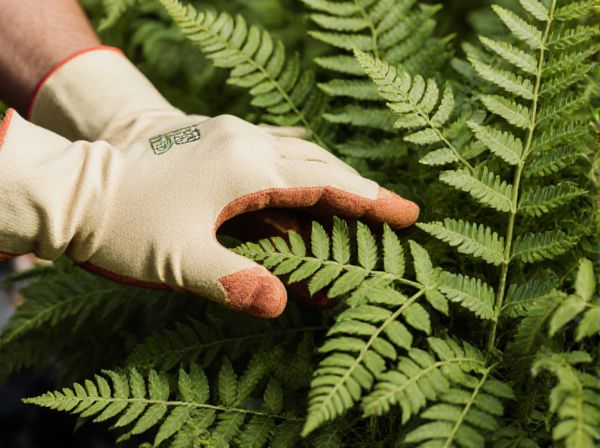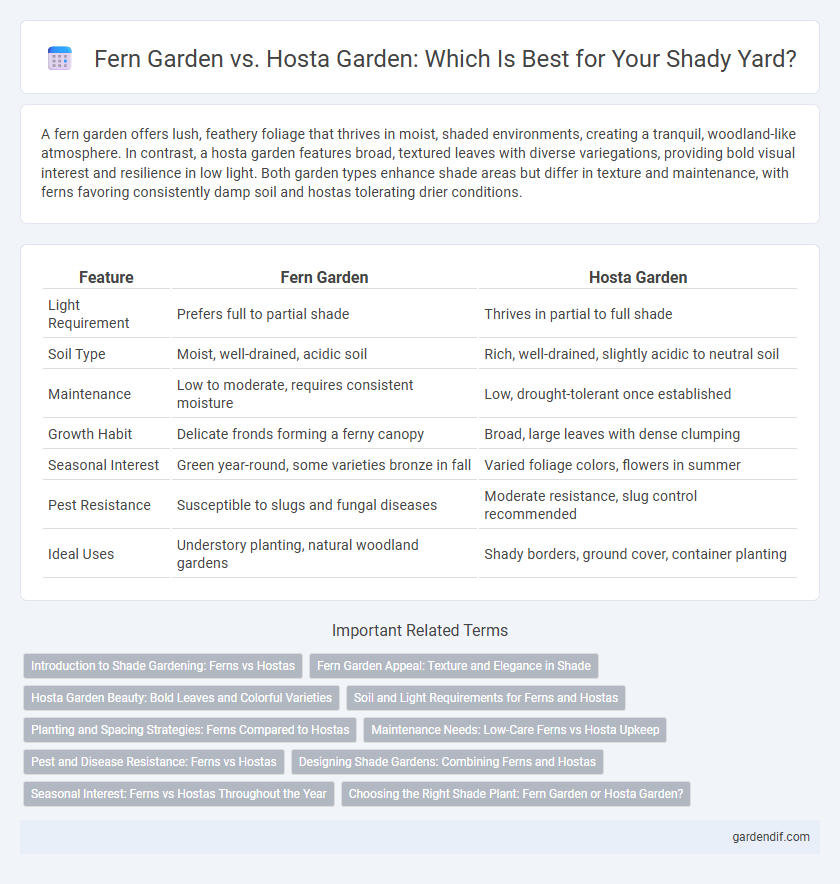
fern garden vs hosta garden Illustration
A fern garden offers lush, feathery foliage that thrives in moist, shaded environments, creating a tranquil, woodland-like atmosphere. In contrast, a hosta garden features broad, textured leaves with diverse variegations, providing bold visual interest and resilience in low light. Both garden types enhance shade areas but differ in texture and maintenance, with ferns favoring consistently damp soil and hostas tolerating drier conditions.
Table of Comparison
| Feature | Fern Garden | Hosta Garden |
|---|---|---|
| Light Requirement | Prefers full to partial shade | Thrives in partial to full shade |
| Soil Type | Moist, well-drained, acidic soil | Rich, well-drained, slightly acidic to neutral soil |
| Maintenance | Low to moderate, requires consistent moisture | Low, drought-tolerant once established |
| Growth Habit | Delicate fronds forming a ferny canopy | Broad, large leaves with dense clumping |
| Seasonal Interest | Green year-round, some varieties bronze in fall | Varied foliage colors, flowers in summer |
| Pest Resistance | Susceptible to slugs and fungal diseases | Moderate resistance, slug control recommended |
| Ideal Uses | Understory planting, natural woodland gardens | Shady borders, ground cover, container planting |
Introduction to Shade Gardening: Ferns vs Hostas
Shade gardening thrives on selecting plants adapted to low-light environments, with ferns and hostas as prime examples. Ferns offer delicate, feathery fronds that enhance texture and thrive in moist, shaded areas, while hostas feature broad, lush leaves providing bold color variety and reliable growth in diverse shade conditions. Understanding the distinct moisture and soil preferences of ferns and hostas is essential for successful shade garden design and plant health.
Fern Garden Appeal: Texture and Elegance in Shade
Fern gardens create a luxurious texture and elegant ambiance in shaded areas, thriving in low-light conditions with their delicate fronds and lush greenery. Unlike hosta gardens, which emphasize broad, bold leaves and vibrant variegation, fern gardens offer a finer, more intricate foliage pattern that complements woodland-style landscapes. Fern species such as the Japanese Painted Fern and Lady Fern enhance garden depth and sophistication, making them ideal for adding layered textures to shaded retreats.
Hosta Garden Beauty: Bold Leaves and Colorful Varieties
Hosta gardens captivate with their bold, oversized leaves and diverse range of vibrant colors, from deep greens to striking blues and variegated patterns. These shade-loving perennials create lush foliage displays that contrast beautifully with the delicate fronds of a fern garden. Their low maintenance and adaptability to shaded environments make hostas a preferred choice for adding dynamic texture and visual interest to any shaded garden space.
Soil and Light Requirements for Ferns and Hostas
Ferns thrive in moist, well-drained, acidic soil with high organic matter, preferring deep shade or dappled light to avoid leaf scorch. Hostas tolerate a broader range of soil types, favoring rich, well-drained soil with neutral to slightly acidic pH and perform well in partial to full shade, though some varieties can handle morning sun. Optimal growth for both requires protection from harsh afternoon sun, but ferns demand consistently moist conditions while hostas are more drought-tolerant once established.
Planting and Spacing Strategies: Ferns Compared to Hostas
Ferns thrive in densely planted clusters with spacing around 12-18 inches to mimic their natural woodland environment, promoting lush, layered foliage that thrives in moist, shaded areas. Hostas require more generous spacing of 18-24 inches to accommodate their broad leaves and allow proper air circulation, reducing the risk of fungal diseases common in shaded gardens. Effective planting and spacing strategies for ferns and hostas enhance growth vigor, optimize shade tolerance, and contribute to a dynamic, texturally diverse garden under low light conditions.
Maintenance Needs: Low-Care Ferns vs Hosta Upkeep
Ferns in shade gardens require minimal maintenance, thriving with consistent moisture and occasional pruning to remove dead fronds. Hostas demand moderate upkeep, including regular watering, division every few years, and vigilant pest control to manage slugs and deer. The lower maintenance needs of ferns make them ideal for gardeners seeking lush greenery with less effort compared to the more demanding hosta care routine.
Pest and Disease Resistance: Ferns vs Hostas
Ferns generally exhibit higher pest and disease resistance compared to hostas, which are often vulnerable to slug and snail infestations as well as fungal diseases like leaf spot. Fern species thrive in shaded, moist environments with minimal chemical intervention, significantly reducing pest issues. Hostas require regular monitoring and treatment to manage common pests and diseases, making ferns a lower-maintenance option for shaded gardens seeking resilient plant varieties.
Designing Shade Gardens: Combining Ferns and Hostas
Designing shade gardens by combining ferns and hostas creates a lush, textured landscape ideal for low-light areas. Ferns provide delicate, feathery fronds that complement hostas' broad, variegated leaves, enhancing diversity and visual interest. This combination thrives in moist, well-drained soils with consistent shade, promoting healthy growth and year-round appeal.
Seasonal Interest: Ferns vs Hostas Throughout the Year
Ferns provide vibrant greenery and delicate texture in spring and summer but often fade by fall, while hostas deliver broad, lush foliage that transitions into striking yellow or bronze tones, sustaining visual interest well into autumn. Hostas also produce fragrant flowers in late summer, adding seasonal dimension beyond the growing season. Combining ferns and hostas can create dynamic shade gardens with evolving seasonal appeal, capitalizing on their complementary growth cycles and textures.
Choosing the Right Shade Plant: Fern Garden or Hosta Garden?
Fern gardens thrive in consistently moist, well-drained soils and provide delicate, feathery foliage that adds texture to shaded landscapes. Hosta gardens adapt well to a variety of soil types, featuring broad, lush leaves and attractive flowers that attract pollinators. Selecting the right shade plant depends on soil moisture levels, desired foliage texture, and garden maintenance preferences.
fern garden vs hosta garden Infographic

 gardendif.com
gardendif.com